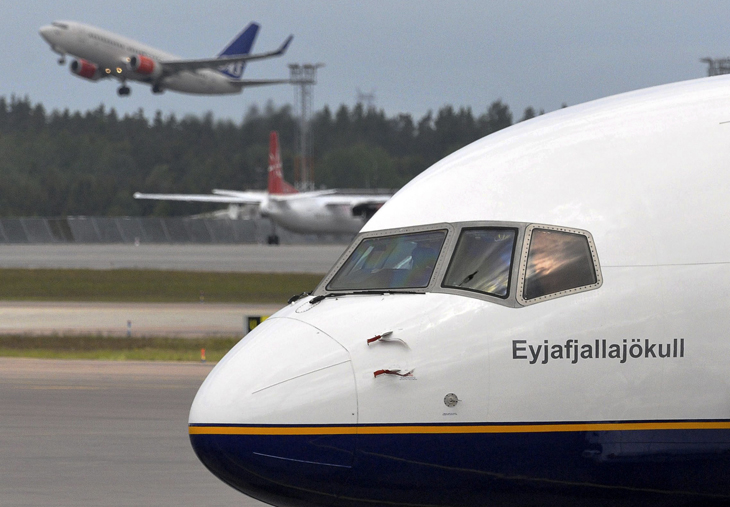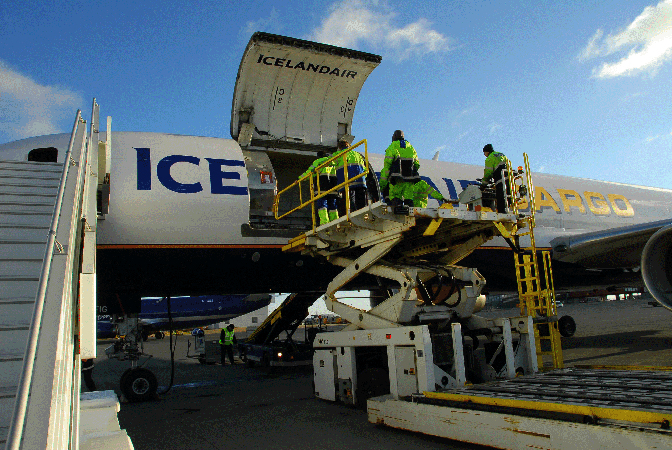

 While
it seemed for a while that things were going up in smoke, herring,
mackerel and tons of codfish remain Icelandair Cargo’s most
important product, carried aloft (nature permitting) aboard the carrier’s
aircraft every single day. While
it seemed for a while that things were going up in smoke, herring,
mackerel and tons of codfish remain Icelandair Cargo’s most
important product, carried aloft (nature permitting) aboard the carrier’s
aircraft every single day.
‘Volcano’ was the ‘it
word’ for Iceland this year (more about that later), but Icelandair
Cargo has other fish to fry as 2011 continues.
“Sea fish, together with vegetables,
fruits and medical products, account for about 90 percent of our total
air freight volume,” states Gunnar Mar Sigurfinnsson, Managing
Director for Icelandair.
The other ten percent is contributed
by the extremely tough Iceland horses, which are mainly exported to
European horse breeders, and all sorts of general cargo that lands
in the five freighters and lower deck compartments of Icelandair,
the sister passenger airline. Last year nearly 30,000 tons were transported
on behalf of Icelandair Cargo, resulting in a turnover of USD$100
million in total. That’s why “we were able to contribute
a very satisfying margin to the group,” says Sigurfinnsson without
revealing detailed profit figures. The
air freight flyer is part of Icelandair Holding, an umbrella organization
uniting eight different enterprises. Ranked first is the passenger
airline Icelandair, next in revenues comes the cargo offspring, followed
by travel agencies, a hotel chain, ground handling and technical services
at the Icelandic airports and, last but not least, regional carrier
Loftleidir Icelandic, which offers domestic flights together with
airlift to and from neighboring Greenland.
Gunnar, born in 1965, started from the
ground up at Icelandair, with his first job as aircraft loader back
in July 1986.
“Apart from flying an aircraft,
I’ve taken on just about every assignment possible ever since,
at the airline,” he recalls. His career record is quite impressive,
with General Manager Germany and Central Europe from 1996 to 2005
as one highlight and Senior Vice President Sales and Marketing at
the carrier’s headquarters in Reykjavik as another one.
When he took over as head at Icelandair
Cargo in May 2008, the aviation world was still in order. Iceland’s
economy was thriving, the national currency króna (crown) was
extremely strong and the locals were importing massive amounts of
consumer goods.
“In July 2007 alone, we had a
backlog of one hundred cars bought by our nationals in the U.S. to
be brought to our hub Keflavik,” he says, looking back at the
good old days.
It took his airline 52 long weeks to
fly the enormous amount of purchased cars out of the States to their
new Icelandic owners.
 |
In Fall 2008, however, Sigurfinnsson
learned his first basic cargo lesson; the economy collapsed almost
completely and transport volumes shrank by 60 percent. “In that
highly hostile situation, my management team and I had to take immediate
steps to assure Icelandair Cargo’s further survival,”
he says, describing those crucial weeks and months. The consequence
of the crash was that the intercontinental network was stripped and
completely restructured, two of the five B757 freighters the carrier
operated were leased to TNT and DHL on ACMI terms, thus guaranteeing
a steady cash flow, and—most sobering of all—thirty percent
of the freight airlines’ total workforce had to be laid off.
“It was a heartbreaking decision,
but we had no alternative due to the massive losses we incurred during
those days,” Sigurfinnsson explains.
The carrier had just gained some ground
when the next tragedy occurred – the unpronounceable volcano,
Eyjafjallajokull, erupted in April 2010.
“In those days, either our home
base Keflavik or Akureyri in northern Iceland was closed due to the
drifting ash clouds.
“We had to, more or less, decide
very spontaneously to which airport we would direct our thermo trucks,
which were loaded with fresh fish, in order to fly the perishables
out of the country,” he says. After having decided this, the
next question confronted was at which airports could the freighters
operate from? While Eyjafjallajokull continued to eject ash into the
atmosphere, there were only some places in Norway or Scotland still
open for air traffic. During those days the manager and most of his
airline’s employees didn’t see their homes, opting to
sleep at the office instead.
However, despite the traffic turmoil
caused by the volcano, Icelandair Cargo presented 2010 as its most
successful financial year ever in history. For fiscal 2011, Sigurfinnsson
expects an even better result since volumes keep on rising. But instead
of imports, it is now mainly exports that drive the carrier’s
tonnage. “There is growing market
demand for fresh sea fish,” he says. The cold waters around
his island offer plenty of this desired product.
Heiner Siegmund/Flossie
|


![]() 100%
Green
100%
Green